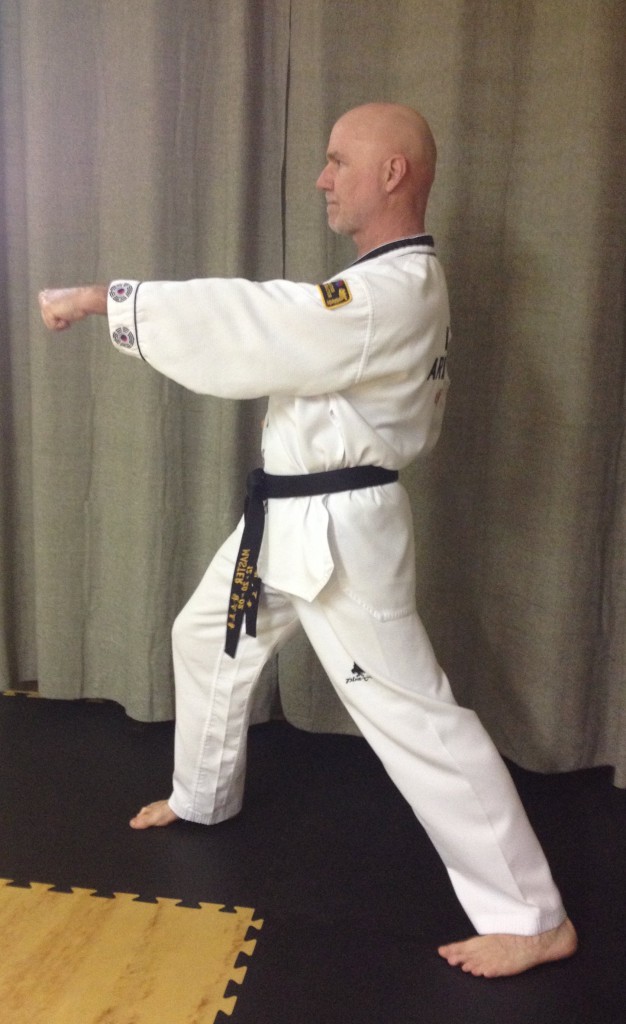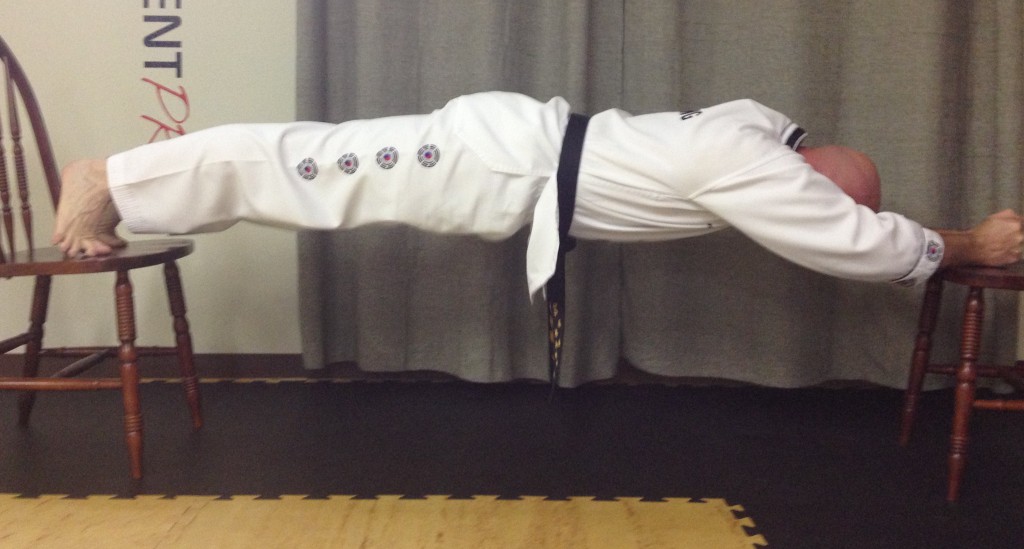 When I encountered the kettlebell, it was love at first swing.
When I encountered the kettlebell, it was love at first swing.
I knew immediately that this was a tool that would complement (rather than interfere with) martial arts training. Traditional efforts in the gym trying to develop big muscles made me strong, sore, and SLOW.
Swinging a kettlebell is clearly not traditional weight training. It will help your martial arts practice if you have the proper technique and a clear understanding of what you are trying to master. Two specific areas of martial arts skills that the kettlebell swing can help improve are:
- Tense/Relax Cycling, and
- Breath Control
If you feel you have been missing out on strength training or you want to add a different form of cardiovascular endurance training to your routine the kettlebell swing may be exactly what you need. But, the kettlebell swing has even more to offer if you are a martial artist.
Tense/Relax Cycling
Exceptional athletes have the ability to rapidly contract their muscles, or create tension, and then just as quickly release that expression of energy. In fact, one of the things that separates great athletes from good athletes is the ability to create a greater amount tension in a shorter period of time than their competitors and then to more quickly return to a relaxed state. This makes them more efficient. I call this skill the tense/relax cycling skill. This is the ability to rapidly command the desired muscles, and only those muscles, to tense and then to release this tension.
Visualize your favorite professional athlete. Would you characterize their best performances as tense or relaxed? Do you think their impressive performances require no effort? Of course not. They just make it look easy because there is no unnecessary tension.
The kettlebell swing is an athletic skill. It is one that requires tension, muscular control, balance, coordination and significant energy expenditure. This is complex movement pattern that incorporates many practical elemental skills.
As the kettlebell descends down and behind the kettlebell athlete, the maximum amount of force is experienced. The maximum amount of force is presented to the grip and the shoulders and then downward through the posterior chain and into the ground. This moment of maximum exertion (or tension) requires that the kettlebell athlete strongly contract the muscles of the abdomen (or core). The kettlebell doesn’t stay at the bottom position for long. So, this contraction of the core is brief.
The big muscles of the hamstring group and the glutes drive the hips forward and upward to project energy into the kettlebell. As the hips move forward, they must encounter an opposing force otherwise they will move far enough forward to put the lower back into excessive extension. Repetitively doing this will probably make your back hurt.
As the kettlebell moves forward, the kettlebell athlete returns to the standing position. This postural position is referred to as the “plank” position. It is a neutral alignment of the neck, thoracic spine, and lumbar spine. In order to achieve this position, there must be a significant, simultaneous contraction of many muscles. There are few muscles excluded from this contraction. The lats should be strongly contracted to connect the arms to the torso. The abs and core muscles should be strongly contracted to transfer the power from the legs to the arms and to prevent hyperextension of the lower back. The muscles of the legs should be strongly contracted to provide a strong base of support and rooting of the body to the ground. The kettlebell is only floating at the top of the swing for a brief period of time, so this display of high tension is momentary.
 How do we improve on a particular skill? Skills improve through focused and intelligent practice. The rate of progress is also related to 1) the frequency of practice; 2) the number of repetitions; and 3) the load or intensity of the practice.
How do we improve on a particular skill? Skills improve through focused and intelligent practice. The rate of progress is also related to 1) the frequency of practice; 2) the number of repetitions; and 3) the load or intensity of the practice.
The kettlebell swing provides the martial artist with an excellent platform for improving the tense/relax cycling skill. This is a drill that can be practiced with a large number of repetitions and with great frequency. In addition, the drill is obviously practiced with a load that may sometimes be significant. This all adds up to imply that swinging a kettlebell is an excellent way to improve the martial artist’s ability to rapidly and strongly tense muscles and then just as rapidly release this tension.
Focus on this aspect of the kettlebell swing and you will find you delivery more power in your kicks and strikes. And, your newfound ability to quickly relax will greatly reduce your fatigue.
Breath Control
We have looked at the principle of tense/relax cycling and how a martial artist can use the kettlebell swing to improve this skill. Now, we will look at how the kettlebell swing can be employed to give the martial artist better breath control.
The topic of breathing and breath control could take up several volumes. We need oxygen to provide energy to our muscles and to our brain. Carbon dioxide is a waste by-product of energy expenditure. Breathing is the mechanism by which oxygen is added to the blood during the inhalation phase and CO2 is expelled during the exhalation phase. Both of these are important! Inefficient breathing techniques will cause premature fatigue and adversely affect cognition.
Breath control is an essential skill for everyone but especially for martial artists. Two of the breath control abilities that are required by a martial artist are: 1) a sharp, strong exhalation (or yell) to accompany a maximum contraction, breaking technique, or punch; and 2) the ability to effectively inhale while the core and abdominal muscles are contracted (as they are during a fight).
A forced exhalation through a restriction causes many of the abdominal muscles to contract strongly. Imagine you are blowing up a very stubborn balloon. This is what I mean by exhalation with restriction. This effort develops a tension that spreads throughout the entire body. Yelling simulates this effect and has been used for centuries in martial arts communities. This practice has become commonplace in the world of tennis (among other sports) where many players yell each time they hit the tennis ball. The technique of rapidly and forcefully expelling air through a restricted orifice will help you generate much more tension and power.
It is difficult to inhale when your abdominal muscles are contracted. It is virtually impossible to do so with an inefficient, chest-breathing technique. To breath when your stomach muscles are tight, you must pull the diaphragm downward. Whenever you step into the ring to fight, your abdominal muscles automatically contract to help protect the vital organs behind them. So, you should learn to breathe with these muscles contracted. Even if you are not a martial artist, these muscles contract in the same way whenever you are under stress (at work, at home, or during sports) or whenever you are afraid. Learning to breathe while your abdominal muscles are strongly contracted will improve your endurance whenever your are excited or under the stress of competition.
Both of these breathing techniques are skills. You can improve your breath control abilities through intelligent and focused practice. The kettlebell swing provides an excellent training opportunity to improve these abilities.
The total tension position at the top of the kettlebell swing (or the plank position) is a great time to use the sharp exhalation to generate a bit more tension. And, the quick sniff of air through the nose at the bottom of the kettlebell swing is an opportunity to practice inhalation with braced abdominal muscles.
Your skill will improve quickly if you practice with focus, if there are lots of reps, and if there is significant intensity. The kettlebell swing provides the ideal scenario for all of these requirements.
Workout with Purpose
Often, we are given exercises with the sole purpose of working and strengthening a specific muscle group. Or, perhaps the drills are designed to increase the size of a muscle. While these activities are not necessarily bad, wouldn’t it be better if the purpose of an exercise was to help us improve our ability to perform in a real-world situation or in a sports activity?
The kettlebell swing can be utilized for just such a reason. If you focus on the correct aspects of the technique, the kettlebell swing can improve your tense/relax cycling skill and improve your ability to use your breath to facilitate the development of tension. These skills are essential to all martial artists. I am sure you will see rapid progress if you focus on these goals during your kettlebell swings.
***
Jay Armstrong is a Senior RKC, 6 Degree Black Belt TKD, and Master Z-Health Trainer. The past 30 years have been dedicated to helping others develop confidence through increased strength and pain-free, exceptional mobility. His quest for knowledge continues. He runs The Kettlebell Club in Houston, Texas and can be reached here.